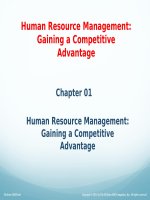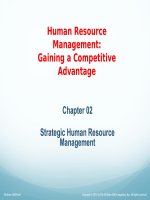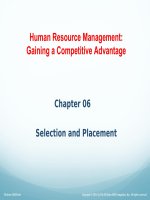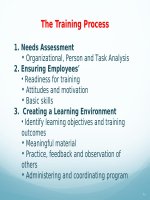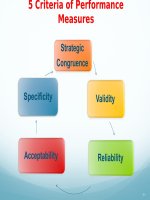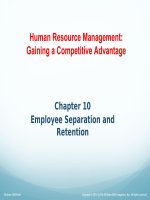Human resource management gaining a competitive advantage 10th edition by noe hollenbeck gerhart wright test bank
Bạn đang xem bản rút gọn của tài liệu. Xem và tải ngay bản đầy đủ của tài liệu tại đây (501.54 KB, 111 trang )
Human Resource Management: Gaining A Competitive Advantage 10th edition by Raymond A. Noe, John
R. Hollenbeck, Barry Gerhart, Patrick M. Wright Test Bank
Link full download test bank: />Link full download solution manual: />
Chapter 02 Strategic Human Resource Management
True / False Questions
1.
The goal of strategic management in an organization is to deploy and allocate resources in a way that it
provides the company with a competitive advantage.
TRUE
The goal of strategic management in an organization is to deploy and allocate physical, organizational, and
human resources in a way that gives it a competitive advantage.
AACSB:
Analytic Accessibility:
Keyboard Navigation
Blooms:
Remember
Difficulty: 1
Easy
Learning Objective: 02-01 Describe the differences between strategy formulation
and strategy implementation.
Topic: Introduction
2.
To be maximally effective, the human resource management function of a company must be isolated
2-1
Copyright © 2016 McGraw-Hill Education. All rights reserved. No reproduction or distribution without the prior written consent of McGraw-Hill
Education.
from the company's strategic management process.
FALSE
To be maximally effective, the human resource management function of a company must be integrally involved in
the company's strategic management process. This means that human resource managers should have input into
the strategic plan, have specific knowledge of the organization's strategic goals, know what types of skills, behaviors,
and attitudes are needed to support the strategic plan, and develop programs to ensure that employees have those
skills, behaviors, and attitudes.
AACSB:
Analytic Accessibility:
Keyboard Navigation
Blooms:
Understand
Difficulty: 2
Medium
Learning Objective: 02-01 Describe the differences between strategy formulation and strategy
implementation.
2-2
Copyright © 2016 McGraw-Hill Education. All rights reserved. No reproduction or distribution without the prior written consent of McGraw-Hill
Education.
Topic:
Introduction
3.
Strategic planning groups decide on a strategic direction during the strategy implementation phase.
FALSE
During strategy formulation, the strategic planning groups of an organization decide on a strategic direction by
defining the company's mission and goals. During strategy implementation, the organization follows
through on the chosen strategy.
AACSB:
Analytic Accessibility:
Keyboard Navigation
Blooms:
Remember
Difficulty: 1
Easy
Learning Objective: 02-02 List the components of the strategic management process.
Topic: What is Strategic Management?
4.
Strategy implementation includes structuring an organization and allocating resources.
TRUE
During strategy implementation, an organization follows through on the strategy chosen in the strategy
formulation stage. This consists of structuring the organization, allocating resources, ensuring that the firm has
skilled employees in place, and developing reward systems that align employee behavior with the organization's
2-30
Copyright © 2016 McGraw-Hill Education. All rights reserved. No reproduction or distribution without the prior written consent of McGraw-Hill
Education.
strategic goals.
AACSB:
Analytic Accessibility:
Keyboard Navigation
Blooms:
Remember
Difficulty: 1
Easy
Learning Objective: 02-02 List the components of the strategic management process.
Topic: What is Strategic Management?
2-31
Copyright © 2016 McGraw-Hill Education. All rights reserved. No reproduction or distribution without the prior written consent of McGraw-Hill
Education.
5.
In a two-way linkage, an organization is restricted from considering the human resource issues while
formulating its strategic plan.
FALSE
Two-way linkage allows for consideration of human resource issues during the strategy formulation process. The
strategic planning team informs the human resource management (HRM) function of the various strategies the
company is considering. Then HRM executives analyze the human resource implications of the various
strategies, presenting the results of this analysis to the strategic planning team.
AACSB:
Analytic Accessibility:
Keyboard Navigation
Blooms:
Remember
Difficulty: 1
Easy
Learning Objective: 02-04 Describe the linkages between HRM
and strategy formulation.
Topic: What is Strategic Management?
6.
Untapped labor pools are an example of a strategic threat to an organization's operating
environment.
FALSE
External analysis consists of examining an organization's operating environment to identify the strategic
opportunities and threats. Examples of threats include potential labor shortages, new competitors entering the
2-32
Copyright © 2016 McGraw-Hill Education. All rights reserved. No reproduction or distribution without the prior written consent of McGraw-Hill
Education.
market, pending legislation that might adversely affect the company, and competitors' technological innovations.
Examples of opportunities are customer markets that are not being served, technological advances that can aid
the company, and labor pools that have not been tapped.
AACSB:
Analytic Accessibility:
Keyboard Navigation
Blooms:
Understand
Difficulty: 2
Medium
Learning Objective: 02-04 Describe the linkages between HRM and strategy formulation.
Topic: Strategy Formulation
2-33
Copyright © 2016 McGraw-Hill Education. All rights reserved. No reproduction or distribution without the prior written consent of McGraw-Hill
Education.
7.
External analysis attempts to identify an organization's strategic opportunities and threats.
TRUE
External analysis consists of examining an organization's operating environment to identify the strategic
opportunities and threats.
AACSB:
Analytic Accessibility:
Keyboard Navigation
Blooms:
Remember
Difficulty: 1
Easy
Learning Objective: 02-04 Describe the linkages between HRM
and strategy formulation.
Topic: Strategy Formulation
8.
Strategic choice describes the way an organization attempts to fulfill its mission and achieve its long-term
goals.
TRUE
The strategic choice is an organization's strategy; it describes the ways the organization will attempt to fulfill its
mission and achieve its long-term goals.
AACSB:
2-34
Copyright © 2016 McGraw-Hill Education. All rights reserved. No reproduction or distribution without the prior written consent of McGraw-Hill
Education.
Analytic Accessibility:
Keyboard Navigation
Blooms:
Remember
Difficulty: 1
Easy
Learning Objective: 02-04 Describe the linkages between HRM and strategy formulation.
Topic: Strategy Formulation
9.
Job design addresses what tasks should be grouped into a particular job.
TRUE
Job design addresses what tasks should be grouped into a particular job. The way that jobs are designed
should have an important tie to the strategy of an organization because the strategy requires either new
and different tasks or different ways of performing the same tasks.
AACSB:
Analytic Accessibility:
Keyboard Navigation
2-35
Copyright © 2016 McGraw-Hill Education. All rights reserved. No reproduction or distribution without the prior written consent of McGraw-Hill
Education.
Blooms:
Remember
Difficulty: 1
Easy
Learning Objective: 02-05 Discuss the more popular typologies of generic strategies and the
various HRM practices associated with
each
. Topic: Strategy
Implementation
10.
The strategy a company is pursuing does not have an impact on the types of employees that it seeks to
recruit and select.
FALSE
Recruitment is the process through which an organization seeks applicants for potential employment.
AACSB:
Analytic Accessibility:
Keyboard Navigation
Blooms:
Understand
Difficulty: 2
Medium
Learning Objective: 02-05 Discuss the more popular typologies of generic strategies and the
2-36
Copyright © 2016 McGraw-Hill Education. All rights reserved. No reproduction or distribution without the prior written consent of McGraw-Hill
Education.
various HRM practices associated with
each
. Topic: Strategy
Implementation
11.
Training is a planned effort to facilitate the learning of job-related knowledge, skills, and behavior by
employees.
TRUE
A number of skills are instilled in employees through training and development. Training is a planned effort
to facilitate the learning of job-related knowledge, skills, and behavior by employees.
AACSB:
Analytic Accessibility:
Keyboard Navigation
Blooms:
Remember
Difficulty: 1
Easy
Learning Objective: 02-05 Discuss the more popular typologies of generic strategies and the
various HRM practices associated with
each
. Topic: Strategy
Implementation
2-37
Copyright © 2016 McGraw-Hill Education. All rights reserved. No reproduction or distribution without the prior written consent of McGraw-Hill
Education.
12.
Companies that are not diversified use objective measures of performance to evaluate managers.
FALSE
Companies that are "steady state" (not diversified) tend to have evaluation systems that call for subjective
performance assessments of managers. This stems from the fact that those above the first-level managers in
the hierarchy have extensive knowledge about how the work should be performed.
AACSB:
Analytic Accessibility:
Keyboard Navigation
Blooms:
Remember
Difficulty: 2
Medium
Learning Objective: 02-05 Discuss the more popular typologies of generic strategies and the
various HRM practices associated with
each
. Topic: Strategy
Implementation
13.
Executives who have extensive knowledge of the behaviors that lead to effective performance tend to focus on
evaluating the objective performance results of their subordinate managers.
FALSE
2-38
Copyright © 2016 McGraw-Hill Education. All rights reserved. No reproduction or distribution without the prior written consent of McGraw-Hill
Education.
Executives who have extensive knowledge of the behaviors that lead to effective performance use performance
management systems that focus on the behaviors of their subordinate managers.
AACSB:
Analytic Accessibility:
Keyboard Navigation
Blooms:
Remember
Difficulty: 1
Easy
Learning Objective: 02-05 Discuss the more popular typologies of generic strategies and the
various HRM practices associated with
each
. Topic: Strategy
Implementation
2-39
Copyright © 2016 McGraw-Hill Education. All rights reserved. No reproduction or distribution without the prior written consent of McGraw-Hill
Education.
14.
By tying pay to performance, a company can elicit specific activities and levels of performance from employees.
TRUE
By tying pay to performance, a company can elicit specific activities and levels of performance from employees.
AACSB:
Analytic Accessibility:
Keyboard Navigation
Blooms:
Remember
Difficulty: 1
Easy
Learning Objective: 02-05 Discuss the more popular typologies of generic strategies and the
various HRM practices associated with
each
. Topic: Strategy
Implementation
15.
Concentration strategies require that an organization bring radical change to the current skills that exist in the
organization.
FALSE
Internal growth strategies focus on new market and product development, innovation, and joint ventures.
Concentration strategies require that organization maintain the current skills that exist in the organization.
2-40
Copyright © 2016 McGraw-Hill Education. All rights reserved. No reproduction or distribution without the prior written consent of McGraw-Hill
Education.
AACSB:
Analytic Accessibility:
Keyboard Navigation
Blooms:
Understand
Difficulty: 2
Medium
Learning Objective: 02-05 Discuss the more popular typologies of generic strategies and the
various HRM practices associated with
each
. Topic: Strategy
Implementation
2-41
Copyright © 2016 McGraw-Hill Education. All rights reserved. No reproduction or distribution without the prior written consent of McGraw-Hill
Education.
16.
An overall cost leadership strategy is achieved primarily by offering unique product features.
FALSE
Overall cost leadership is achieved by constructing efficient large-scale facilities, by reducing costs through
capitalizing on the experience curve, and by controlling overhead costs and costs in such areas as research and
development, service, sales force, and advertising.
AACSB:
Analytic Accessibility:
Keyboard Navigation
Blooms:
Remember
Difficulty: 1
Easy
Learning Objective: 02-05 Discuss the more popular typologies of generic strategies and the
various HRM practices associated with
each
. Topic: Strategy
Implementation
17.
Companies engaged in a cost strategy require employees to have reduced concern for quantity and a
short-term focus.
FALSE
2-42
Copyright © 2016 McGraw-Hill Education. All rights reserved. No reproduction or distribution without the prior written consent of McGraw-Hill
Education.
Companies engaged in a cost strategy require employees to have a high concern for quantity and a short-term
focus, to be comfortable with stability, and to be risk averse. These employees are expected to exhibit role
behaviors that are relatively repetitive and performed independently, or autonomously.
AACSB:
Analytic Accessibility:
Keyboard Navigation
Blooms:
Remember
Difficulty: 1
Easy
Learning Objective: 02-05 Discuss the more popular typologies of generic strategies and the
various HRM practices associated with
each
. Topic: Strategy
Implementation
2-43
Copyright © 2016 McGraw-Hill Education. All rights reserved. No reproduction or distribution without the prior written consent of McGraw-Hill
Education.
18.
Companies engaged in cost strategies develop internally consistent pay systems with negligible pay differentials
between superiors and subordinates.
FALSE
Companies engaged in cost strategies promote internally and develop internally consistent pay systems
with high pay differentials between superiors and subordinates.
AACSB:
Analytic Accessibility:
Keyboard Navigation
Blooms:
Understand
Difficulty: 2
Medium
Learning Objective: 02-05 Discuss the more popular typologies of generic strategies and the
various HRM practices associated with
each
. Topic: Strategy
Implementation
19.
Employees in companies with a differentiation strategy need to have only a moderate concern for quantity.
TRUE
Employees in companies with a differentiation strategy need to be highly creative and cooperative; to have only a
2-44
Copyright © 2016 McGraw-Hill Education. All rights reserved. No reproduction or distribution without the prior written consent of McGraw-Hill
Education.
moderate concern for quantity, a long-term focus, and a tolerance for ambiguity; and to be risk takers.
AACSB:
Analytic Accessibility:
Keyboard Navigation
Blooms:
Remember
Difficulty: 1
Easy
Learning Objective: 02-05 Discuss the more popular typologies of generic strategies and the
various HRM practices associated with
each
. Topic: Strategy
Implementation
2-45
Copyright © 2016 McGraw-Hill Education. All rights reserved. No reproduction or distribution without the prior written consent of McGraw-Hill
Education.
20.
Differentiation companies will have compensation systems that are geared toward internal rather than external
equity.
FALSE
Differentiation companies will have compensation systems that are geared toward external equity, as it is heavily
driven by recruiting needs.
AACSB:
Analytic Accessibility:
Keyboard Navigation
Blooms:
Remember
Difficulty: 1
Easy
Learning Objective: 02-05 Discuss the more popular typologies of generic strategies and the
various HRM practices associated with
each
. Topic: Strategy
Implementation
21.
Strategies emphasizing market share or operating costs are called "external growth" strategies.
FALSE
Strategies emphasizing market share or operating costs are considered "concentration" strategies. Companies that
2-46
Copyright © 2016 McGraw-Hill Education. All rights reserved. No reproduction or distribution without the prior written consent of McGraw-Hill
Education.
attempt to integrate vertically or horizontally or to diversify are exhibiting an "external growth" strategy, usually
through mergers or acquisitions.
AACSB:
Analytic Accessibility:
Keyboard Navigation
Blooms:
Remember
Difficulty: 1
Easy
Learning Objective: 02-06 Describe the different HRM issues and practices associated with various
directional strategies.
Topic: Strategy Implementation
2-47
Copyright © 2016 McGraw-Hill Education. All rights reserved. No reproduction or distribution without the prior written consent of McGraw-Hill
Education.
22.
Companies using concentration strategies attempt to focus on what they do best within their established
markets.
TRUE
Strategies emphasizing market share or operating costs are considered "concentration" strategies. With this type
of strategy, a company attempts to focus on what it does best within its established markets and can be
thought of as "sticking to its knitting."
AACSB:
Analytic Accessibility:
Keyboard Navigation
Blooms:
Remember
Difficulty: 1
Easy
Learning Objective: 02-06 Describe the different HRM issues and practices associated with various
directional strategies.
Topic: Strategy Implementation
23.
Downsizing gives an organization the opportunity to change its culture.
TRUE
In spite of the various challenges, downsizing provides opportunities for human resource management.
Downsizing is often a unique opportunity to change an organization's culture.
2-48
Copyright © 2016 McGraw-Hill Education. All rights reserved. No reproduction or distribution without the prior written consent of McGraw-Hill
Education.
AACSB:
Analytic Accessibility:
Keyboard Navigation
Blooms:
Remember
Difficulty: 1
Easy
Learning Objective: 02-06 Describe the different HRM issues and practices associated with various
directional strategies.
Topic: Strategy Implementation
2-49
Copyright © 2016 McGraw-Hill Education. All rights reserved. No reproduction or distribution without the prior written consent of McGraw-Hill
Education.
24.
Companies going through downsizing often develop compensation programs that tie an
individual's compensation to the company's success.
TRUE
Companies going through downsizing often develop compensation programs that tie an
individual's compensation to the company's success.
AACSB:
Analytic Accessibility:
Keyboard Navigation
Blooms:
Remember
Difficulty: 1
Easy
Learning Objective: 02-06 Describe the different HRM issues and practices associated
with various directional strategies.
Topic: Strategy Implementation
25.
A learning organization constantly monitors its environment, assimilates information, makes decisions,
and flexibly restructures itself to compete in an ever-changing environment.
TRUE
A learning organization requires a company to be in a constant state of learning through monitoring the
environment, assimilating information, making decisions, and flexibly restructuring to compete in an everchanging environment. Companies that develop such a learning capability have a competitive advantage.
2-40
Copyright © 2016 McGraw-Hill Education. All rights reserved. No reproduction or distribution without the prior written consent of McGraw-Hill
Education.
AACSB:
Analytic Accessibility:
Keyboard Navigation
Blooms:
Remember
Difficulty: 1
Easy
Learning Objective: 02-06 Describe the different HRM issues and practices associated with various
directional strategies.
Topic: The Role of Human Resources in Providing Strategic Competitive Advantage
Multiple Choice Questions
2-41
Copyright © 2016 McGraw-Hill Education. All rights reserved. No reproduction or distribution without the prior written consent of McGraw-Hill
Education.
26.
Which of the following is a physical resource that a company uses to compete with other companies?
A. Controlling system
B. Technology
C. Planning system
D. Employee skill
E. Experience of employees
A company can use a number of resources to compete with other companies. These resources are physical (such
as plant, equipment, technology, and geographic location), organizational (group relations and the structure,
planning, controlling, and coordinating systems), and human (the experience, skill, and intelligence of
employees).
AACSB:
Analytic Accessibility:
Keyboard Navigation
Blooms:
Remember
Difficulty: 1
Easy
Learning Objective: 02-01 Describe the differences between strategy formulation
and strategy implementation.
Topic: Introduction
27.
A(n)
typically charts how a firm will create value for customers and how it will do so profitably.
2-42
Copyright © 2016 McGraw-Hill Education. All rights reserved. No reproduction or distribution without the prior written consent of McGraw-Hill
Education.
